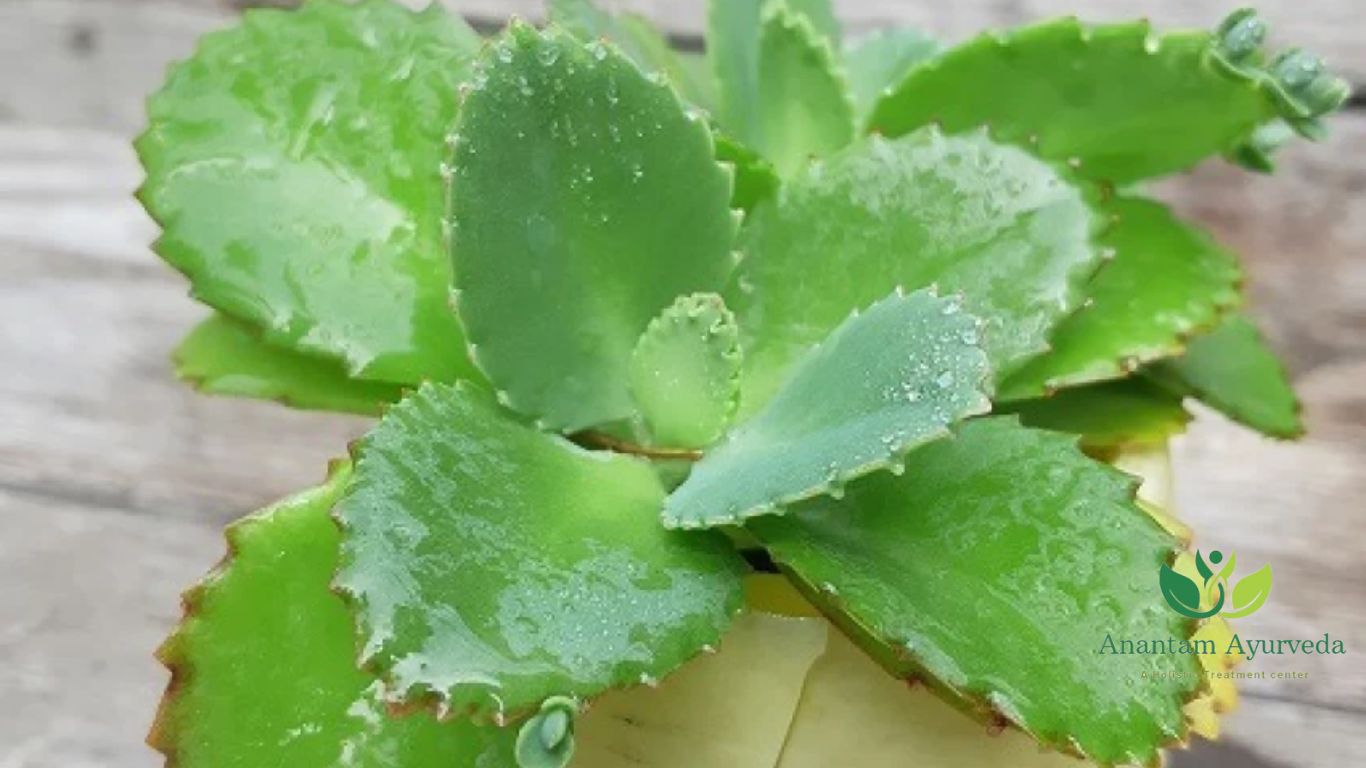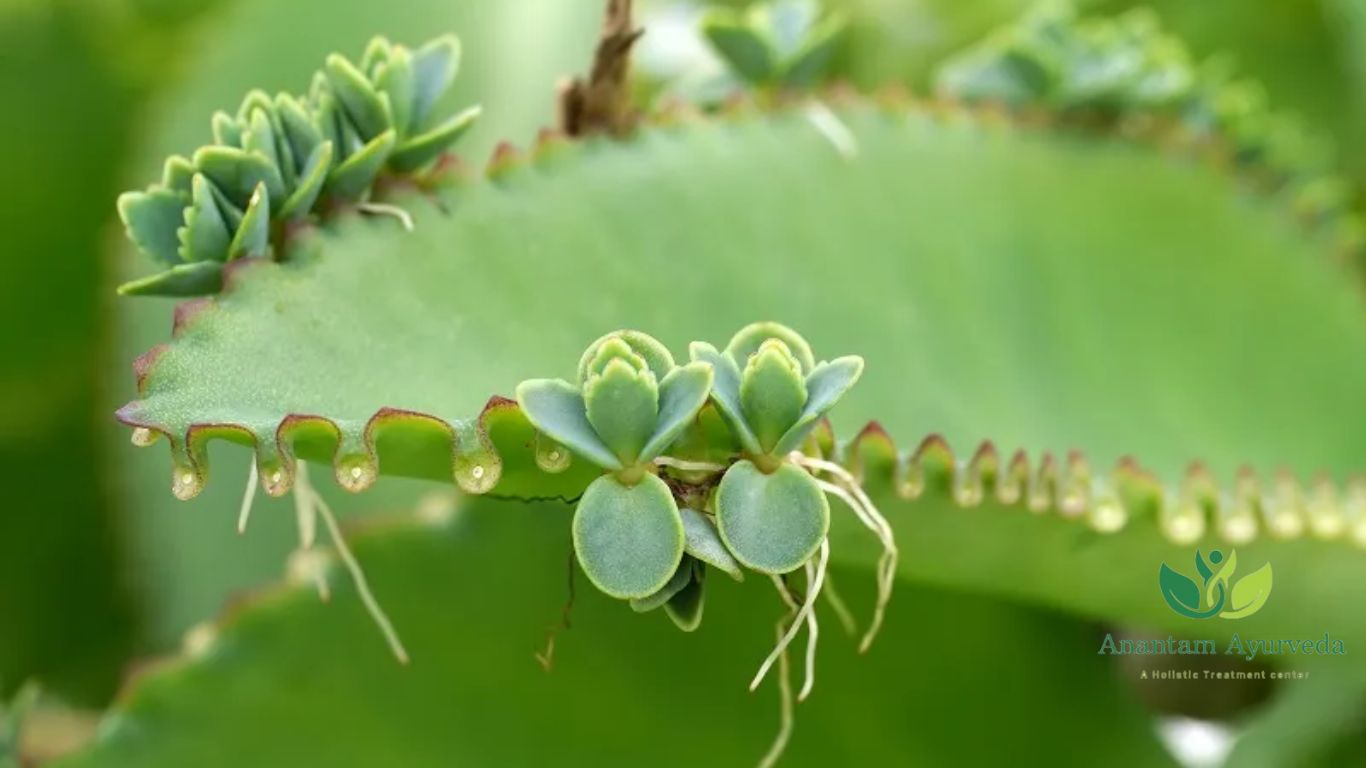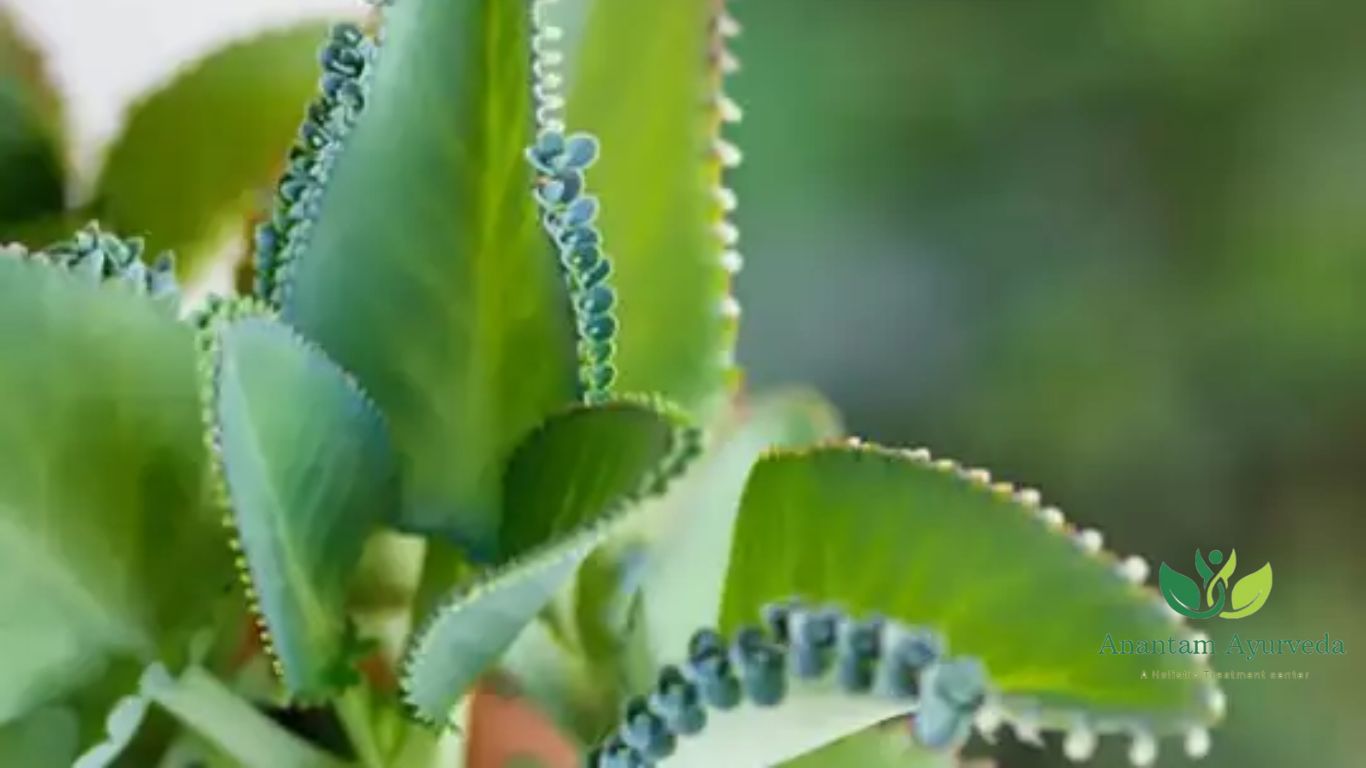Patharchatta (Bryophyllum pinnatum): Pashanbhed and Patharchatta Difference
Introduction
Patharchatta, scientifically known as Bryophyllum pinnatum, is a powerful medicinal herb widely used in Ayurveda for its therapeutic properties. Commonly known as the miracle leaf, life plant, or panfuti, this plant has been traditionally used to treat kidney stones, urinary disorders, wounds, and inflammation. Ayurvedic texts describe its remarkable healing capabilities, making it a valuable herb in holistic medicine.

Botanical Classification of Bryophyllum Pinnatum
- Kingdom: Plantae
- Division: Magnoliophyta
- Class: Magnoliopsida
- Order: Saxifragales
- Genus: Kalanchoe
- Section: Bryophyllum
- Species: K. pinnata
Habitat and Morphology
Parnabeeja is a small shrub growing up to a height of 1-4 feet and is found abundantly in the warm and moist parts of central and eastern India. This plant is a native of Madagascar.
Morphology of Bryophyllum pinnatum
- Height: 1-4 feet
- Stem: Erect, succulent, green, and cylindrical
- Leaves: Thick, fleshy, oval to elliptical with serrated edges; capable of vegetative propagation from leaf margins
- Flowers: Bell-shaped, pendulous, 1-1.5 inches long, greenish-purple or pink in color
- Seeds: Small, round, slimy with small ridges
- Growth Pattern: New growth appears from the edges of the leaf
- Flowering Season: October-November
- Distribution: Found all over India in a temperate climate, especially in rocky, moist, and shady environments
Vernacular Names
Patharchatta is known by different names in various languages:
- English: Air plant, Cathedral bells, Life plant, Miracle leaf, Goethe plant, Bryophyllum
- Hindi: Airavati, Pathacharuti
- Unani: Jhakme hayat
- Telugu: Ranapalaku
- Bengali: Koppata
- Gujarati: Ghaimari
- Marathi: Panfuti
- Oriya: Amarapoi
- Urdu: Jhakme hayat
Synonyms
- Patrabija: New plant originates from leaves
- Raktakusuma: Flowers of parnabija are reddish-purple in color
- Chatushkonaka: Stems are obtusely four-angled
Chemical Composition
The leaves of Bryophyllum pinnatum yield glycosides of quercetin and kaempferol and fumaric acid. The plant extracts possess antifungal properties, making it valuable for treating various infections.
Ayurvedic Properties of Patharchatta
In Ayurveda, Bryophyllum pinnatum is revered for its balancing effects on the body’s energies. It has distinct characteristics that influence various bodily functions:
- Guna (Intrinsic Qualities): Laghu (Easily digestible), Rooksha (Induces dryness in body tissues)
- Rasa (Taste Profile): Kashaya (Astringent), Amla (Sour)
- Vipaka (Post-Digestive Effect): Madhura (Sweet, promoting nourishment and balance)
- Veerya (Potency): Sheeta (Cooling effect, soothes inflammation and excess heat in the body)
- Impact on Tridosha: Effectively pacifies aggravated Kapha and Pitta doshas, making it useful in conditions associated with excessive mucus, inflammation, and excessive body heat.
- Additional Therapeutic Benefits: Supports blood clotting (Raktastambhana) and accelerates wound healing (Vranaropana)
- Pharmacological Action: Functions as a diuretic, aiding in the removal of excess fluids and detoxification of the body.
Parts Used and Recommended Dosage
Primary Part Utilized:
- Leaves are the most medicinally valuable part of the plant.
Dosage Guidelines:
- Fresh Leaf Juice: 10-20 ml, best taken before or after meals for optimal absorption.
- Topical Application: The crushed leaf paste is applied externally to wounds, boils, and skin ailments for faster healing.

Health Benefits of Patharchatta (Bryophyllum Pinnatum)
1. Effective Remedy for Kidney Stones
One of the most significant uses of Patharchatta is in treating kidney stones. It acts as a diuretic (Mutravirechana), helping in the breakdown and expulsion of kidney stones. Regular consumption of Patharchatta juice or leaf decoction helps in flushing out toxins and prevents the formation of new stones.
How to Use:
- Crush 2-3 fresh leaves of Patharchatta and extract the juice.
- Mix it with an equal amount of water and drink it twice daily.
2. Treats Urinary Disorders
Patharchatta is highly beneficial for urinary tract infections (UTI), burning urination (Mutrakrichra), and cystitis. Its antimicrobial properties help reduce bacterial infections in the urinary tract, soothing irritation and inflammation.
How to Use:
- Drink Patharchatta tea made by boiling leaves in water.
- Consume it twice daily for effective relief from UTI symptoms.
3. Wound Healing and Skin Disorders
Bryophyllum pinnatum has anti-inflammatory, antimicrobial, and wound-healing properties. It helps in the rapid healing of cuts, burns, ulcers, and skin infections. Ayurvedic practitioners recommend it for eczema, boils, and abscesses.
How to Use:
- Crush fresh leaves and apply the paste to wounds.
- Use Patharchatta juice for skin infections and inflammation.
4. Relieves Respiratory Issues
This herb is effective in treating cough, asthma, and bronchitis due to its expectorant and anti-inflammatory properties. It helps clear mucus and eases breathing difficulties.
How to Use:
- Prepare a decoction of the leaves and drink it warm.
- Add honey for additional benefits.
5. Regulates Blood Pressure
Patharchatta has hypotensive properties, making it effective for people with high blood pressure. It helps regulate blood circulation and reduces stress on the cardiovascular system.
How to Use:
- Consume fresh leaf juice mixed with water.
- Take it regularly under medical supervision.
6. Aids in Digestive Health
Patharchatta is beneficial for acid reflux, indigestion, and stomach ulcers. Its alkaline nature helps neutralize excess stomach acid and promotes better digestion.
How to Use:
- Drink a mixture of Patharchatta juice and buttermilk to improve digestion.
- Consume it before meals to reduce acidity.
7. Anti-Diabetic Properties
Studies suggest that Bryophyllum pinnatum reduces blood sugar levels by improving insulin sensitivity. It can be used as a supportive therapy for diabetes management.
How to Use:
- Chew 1-2 leaves daily on an empty stomach.
- Take Patharchatta juice in moderation.
How to Use Patharchatta (Bryophyllum Pinnatum) in Ayurveda
1. Fresh Leaf Juice
- Extract 2-3 teaspoons of fresh leaf juice.
- Mix with honey or warm water.
- Drink it once or twice daily for detoxification and kidney health.
2. Patharchatta Tea
- Boil 4-5 leaves in water for 5 minutes.
- Strain and consume warm.
- Helps in respiratory issues and digestion.
3. Patharchatta Paste for External Use
- Crush fresh leaves into a paste.
- Apply directly on wounds, boils, or insect bites.
- Heals skin infections effectively.
4. Dried Powder Form
- Sun-dry the leaves and grind them into powder.
- Consume ½ teaspoon with warm water daily for overall wellness.

Home Remedies of Patharchatta
-
Heal Skin and Wounds: Crush the leaves into a paste and apply it to boils, insect bites, and burns to speed up healing and reduce inflammation.
-
Relieve Dysentery: Prepare a decoction using Bryophyllum pinnatum leaves and Bilwa (Aegle marmelos). Take 30-40 ml in divided doses for relief from dysentery.
-
Control Bleeding Piles & Wounds: Drink 8-10 ml of fresh Parnabeeja leaf juice to manage bleeding piles, wounds, and menstrual cramps (dysmenorrhea).
-
Reduce Diarrhea with Blood: Take 10-15 ml of leaf juice to minimize bleeding in piles and blood-mixed diarrhea.
-
Soothe Swelling: Apply a leaf paste externally to reduce localized swelling.
-
Ease Respiratory Issues: Mix leaf juice with sugar candy and consume it to relieve asthma, colds, and coughs.
-
Boost Antioxidants with Herbal Tea: Dry the leaves, grind them into powder, and brew herbal tea packed with strong antioxidant properties.
-
Relieve Menstrual Pain: Drink juice or a cold infusion of Parnabeeja leaves to ease menstrual cramps.
-
Treat Cough and Asthma: Mix 5-10 ml of leaf juice with honey and take it to soothe cough and asthma symptoms.
Scientific Research on Bryophyllum pinnatum
- Antimicrobial Study: Leaf extracts of Bryophyllum pinnatum demonstrated strong antimicrobial activity against Gram-positive bacteria (Staphylococcus aureus, Bacillus subtilis) and fungi (Candida albicans).
- Anti-cancer Properties: Research suggests Bryophyllum pinnatum leaf extract has growth-inhibitory effects on human cervical cancer cells and may possess anti-HPV activity.
- Anticonvulsant Effect: Studies on mice models indicate the ethanolic extract of Bryophyllum pinnatum leaves helps in reducing seizures and convulsions.
- Hepatoprotective Activity: The aqueous extract of Bryophyllum pinnatum leaves exhibits antioxidant properties that protect the liver from toxin-induced damage.
- Antifungal Potential: Research shows water-stressed Bryophyllum pinnatum has reduced antifungal efficacy, indicating that environmental factors affect its medicinal potency.
Precautions While Using Patharchatta
- Individuals taking Aspirin should consult a doctor before consuming Bryophyllum pinnatum juice or decoction, as it may interact with or reduce the effectiveness of Aspirin.
- However, the external application of the leaf paste is safe and can be used for skin-related conditions without concern.
- Lowered blood pressure in hypotensive individuals.
- Mild gastrointestinal discomfort in some cases.
- Allergic reactions in sensitive individuals.
Pregnant and lactating women should consult an Ayurvedic practitioner before use. People on blood pressure medications or diuretics should use it with caution.
Controversy
Parnabija (Bryophyllum pinnatum) is one of the controversial sources for Pasanabheda, as some scholars argue its classification due to morphological differences and varying pharmacological properties compared to traditional Pasanabheda sources.
Difference Between Pashanbhed and Patharchatta
Both Pashanbhed (Bergenia ligulata) and Patharchatta (Bryophyllum pinnatum) are highly valued in Ayurveda for their ability to treat kidney stones and urinary disorders. Despite their similar applications, these two herbs are botanically distinct and differ in their properties, habitat, and medicinal actions.
| Feature | Pashanbhed (Bergenia ligulata) | Patharchatta (Bryophyllum pinnatum) |
|---|---|---|
| Botanical Name | Bergenia ligulata | Bryophyllum pinnatum |
| Family | Saxifragaceae | Crassulaceae |
| Common Names | Stone Breaker, Pashanbheda, Patharchur | Miracle Leaf, Air Plant, Life Plant, Patharchatta |
| Habitat | Found in Himalayan regions at high altitudes | Found in tropical and subtropical regions, including India, Africa, and Madagascar |
| Plant Type | A perennial herb with thick, rhizomatous roots | A succulent plant with fleshy, water-storing leaves |
| Useful Part | Rhizome (underground stem) | Leaves |
| Medicinal Properties | Diuretic, Lithotriptic (stone-breaking), Anti-inflammatory, Antioxidant, Astringent, Antipyretic | Diuretic, Wound-Healing, Anti-inflammatory, Antimicrobial, Hemostatic (stops bleeding) |
| Ayurvedic Uses | Treats kidney stones, urinary infections, dysuria (painful urination), ulcers, respiratory issues, and fever | Used for kidney stones, urinary tract disorders, skin wounds, bleeding piles, asthma, cough, and dysmenorrhea (painful menstruation) |
| Key Chemical Compounds | Contains bergenin, tannins, gallic acid, and flavonoids | Contains flavonoids, bufadienolides, organic acids, and glycosides |
| Effect on Tridosha | Balances Kapha and Pitta doshas | Pacifies Kapha and Pitta, slightly increases Vata |
| Mode of Action on Kidney Stones | Directly breaks down calcium oxalate kidney stones and reduces their formation | Helps in dissolving and expelling stones naturally by promoting urination (diuretic action) and alkalizing urine |
| Taste (Rasa) | Kashaya (Astringent), Tikta (Bitter) | Kashaya (Astringent), Amla (Sour) |
| Post-Digestive Effect (Vipaka) | Katu (Pungent) | Madhura (Sweet) |
| Potency (Veerya) | Sheeta (Cooling) | Sheeta (Cooling) |
Key Differences Between Pashanbhed and Patharchatta
-
Botanical Family & Origin – Pashanbhed belongs to the Saxifragaceae family and grows in cold mountainous regions, whereas Patharchatta belongs to the Crassulaceae family and thrives in tropical climates.
-
Part Used – Pashanbhed primarily uses the rhizome (root-like stem), while Patharchatta mainly utilizes its leaves for medicinal purposes.
-
Action on Kidney Stones – Pashanbhed works by directly breaking down stones (lithotriptic action), whereas Patharchatta increases urine output (diuretic action) to help expel stones naturally.
-
Other Uses – Pashanbhed is also useful for respiratory ailments, ulcers, and fevers, whereas Patharchatta is more effective for wound healing, bleeding disorders, and skin conditions.
Which One is Better for Kidney Stones?
Both herbs are beneficial, but their mode of action differs:
-
If the stones are large or hard to dissolve, Pashanbhed (Bergenia ligulata) may be more effective.
-
If the stones are small and need to be flushed out naturally, Patharchatta (Bryophyllum pinnatum) is a better option due to its diuretic properties.
Conclusion
Patharchatta (Bryophyllum pinnatum) is a remarkable Ayurvedic herb with potent medicinal properties. From treating kidney stones and urinary disorders to wound healing and respiratory health, its benefits are extensive. Incorporating this powerful herb into daily life can enhance overall health and well-being. However, it should be used under proper guidance for maximum benefits.

Frequently Asked Questions About (FAQs) about Patharchatta (Bryophyllum pinnatum)
1. What is Patharchatta used for in Ayurveda?
Patharchatta is useful for treating kidney stones, urinary disorders, wounds, inflammation, bleeding disorders, and respiratory ailments like asthma and cough. It also has antimicrobial, diuretic, and wound-healing properties.
2. Can Patharchatta help dissolve kidney stones?
Yes, Patharchatta is known for its diuretic and stone-dissolving properties. The fresh leaf juice is often recommended to help break down and eliminate kidney stones naturally.
3. How is Patharchatta consumed for health benefits?
-
Fresh Leaf Juice: 10-20 ml before or after meals.
-
Decoction: Used for treating dysentery and urinary problems.
-
Leaf Paste: Applied externally for wound healing and skin issues.
-
Herbal Tea: Made from dried leaves for antioxidant benefits.
4. Does Patharchatta have any side effects?
When used in recommended doses, it is generally safe. However, excessive consumption may cause gastric irritation or an upset stomach. People on Aspirin medication should consult a doctor before taking it internally.
5. Is Patharchatta effective for wound healing?
Yes, its antibacterial and wound-healing properties make it effective for treating cuts, boils, burns, and ulcers when applied as a leaf paste.
6. Can Patharchatta be used for diabetes?
Some studies suggest that Bryophyllum pinnatum may help regulate blood sugar levels, but more research is needed. Always consult an Ayurvedic practitioner before using it for diabetes management.
7. Can pregnant women use Patharchatta?
Pregnant women should consult a doctor before using Patharchatta, as its effects during pregnancy are not well studied.
8. Where is Patharchatta found in India?
Patharchatta grows wildly across India, especially in tropical and subtropical regions. It is commonly found in gardens, forest areas, and roadside plantations.
9. How does Patharchatta help in cough and asthma?
The juice of the leaves mixed with honey is beneficial for relieving cough, asthma, and respiratory congestion due to its anti-inflammatory and bronchodilator effects.
10. Can I grow Patharchatta at home?
Yes, Patharchatta is a low-maintenance succulent that grows well in pots or gardens. It requires moderate sunlight, minimal watering, and well-drained soil to thrive.
For more detailed information on Ayurvedic herbs, stay connected!
You can follow us on twitter, facebook, instagram & Google News
